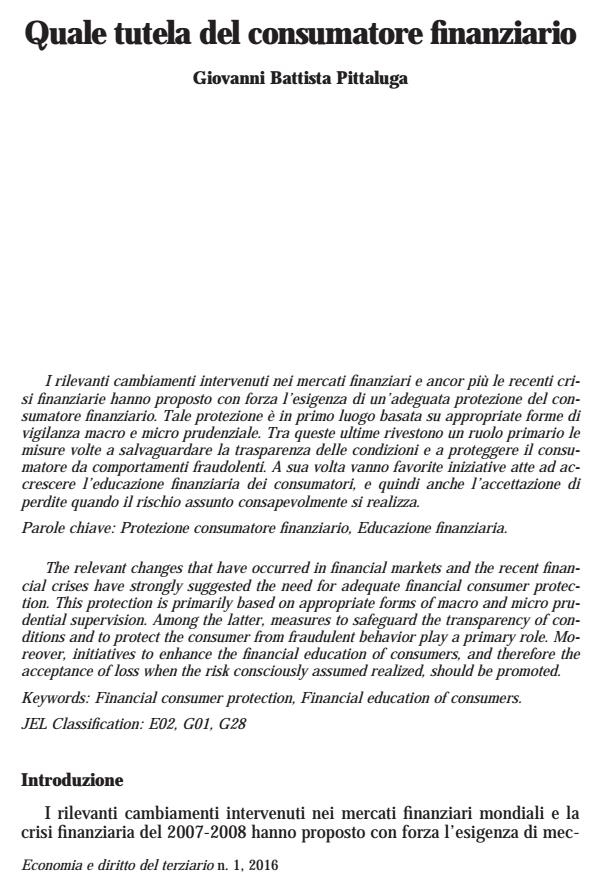Quale tutela del consumatore finanziario
Journal title ECONOMIA E DIRITTO DEL TERZIARIO
Author/s Giovanni Battista Pittaluga
Publishing Year 2016 Issue 2016/1
Language Italian Pages 10 P. 7-16 File size 414 KB
DOI 10.3280/ED2016-001002
DOI is like a bar code for intellectual property: to have more infomation
click here
Below, you can see the article first page
If you want to buy this article in PDF format, you can do it, following the instructions to buy download credits

FrancoAngeli is member of Publishers International Linking Association, Inc (PILA), a not-for-profit association which run the CrossRef service enabling links to and from online scholarly content.
The relevant changes that have occurred in financial markets and the recent financial crises have strongly suggested the need for adequate financial consumer protection. This protection is primarily based on appropriate forms of macro and micro prudential supervision. Among the latter, measures to safeguard the transparency of conditions and to protect the consumer from fraudulent behavior play a primary role. Moreover, initiatives to enhance the financial education of consumers, and therefore the acceptance of loss when the risk consciously assumed realized, should be promoted. .
Keywords: Financial consumer protection, Financial education of consumers
Jel codes: E02, G01, G28
- Allen, F., Carletti, E., An overview of the crisis: causes, consequences and solutions, in «International Review of Finance», 10, 2010, pp. 1-25.
- Banca d’Italia, Disposizioni di vigilanza – La funzione di conformità (compliance), 10 luglio, 2007.
- Banca d’Italia, Che cosa cambia nella gestione delle crisi bancarie, Roma, 2015.
- Bernanke, B., Essays in the Great Depression, Princeton, Princeton University Press, 2000.
- Calomiris, W., Kahn, C., The role of demandable debt in structuring optimal banking arrangements, in «American Economic Review», 81, 1991, pp. 497-513.
- Dell’Atti, S., Sylos Labini, S., La trasparenza informativa. L’impatto delle nuove regole su banche, mercati e clienti, Milano, EGEA, 2014.
- Diamond, D., Financial intermediation and delegated monitoring, in «Review of Economic Studies», 51, 1984, pp. 393-417.
- Diamond, D., Reputation acquisition in debt markets, in «Journal of Political Economy », 97, 1989, pp. 401-419.
- Diamond, D., Dybvig, P., Bank runs, deposit insurance and liquidity, in «Journal of Political Economy», 97, 1983, pp. 401-414.
- Guiso, L., Viviano, E., How much can financial literacy help, in «Review of Finance», 2015.
- Kindleberger, C., Manias, panics and crashes: a history of financial crises, New York, Basic Books, 1978.
- Leland, H., Pyle, H., Informational asymmetries, financial structure, and financial intermediation, in «Journal of Finance», 32, 1977, pp. 371-387.
- Lusardi, A., Mitchell, O., The economic importance of financial literacy: theory and evidence, in «Journal of Economic Literature», 52, 2014, pp. 5-44.
- OECD, PISA 2012 results: students and money, Paris, 2014.
- Sharpe, S.A., Asymmetric information, bank lending and implicit contracts: a stylized model of custom relationship, in «Journal of Finance», 45, 1990, pp. 1069-1087.
- Tarantola, A., La Banca d’Italia e la tutela del consumatore nei servizi bancari e finanziari, intervento al Convegno su «La riforma del codice del consumo: la tutela del consumatore-cliente nei servizi bancari e finanziari», Roma, 19 marzo, 2010.
- Visco, I., Financial education in the aftermath of the financial crisis, in «Review of Economic Conditions in Italy», n. 2, 2010.
- World Bank, Good practices for financial consumer protection, Washington D.C., 2012.
- World Bank, Global survey on consumer protection and financial literacy: results brief, Washington D.C., 2013.
Giovanni Battista Pittaluga, Quale tutela del consumatore finanziario in "ECONOMIA E DIRITTO DEL TERZIARIO " 1/2016, pp 7-16, DOI: 10.3280/ED2016-001002